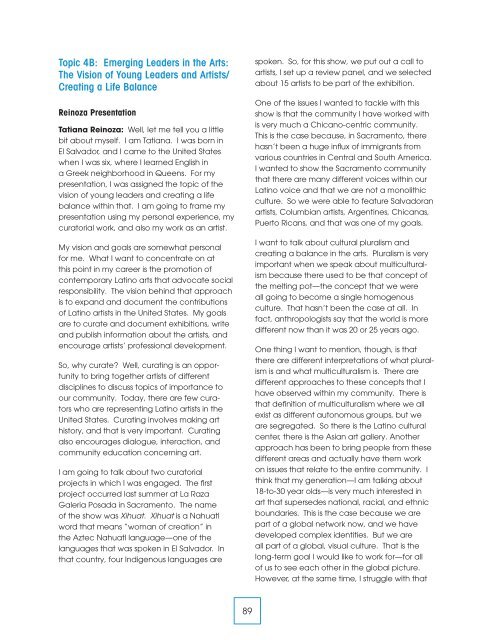The New Face of Arts Leadership in the West - westaf - The Western ...
The New Face of Arts Leadership in the West - westaf - The Western ...
The New Face of Arts Leadership in the West - westaf - The Western ...
Create successful ePaper yourself
Turn your PDF publications into a flip-book with our unique Google optimized e-Paper software.
Topic 4B: Emerg<strong>in</strong>g Leaders <strong>in</strong> <strong>the</strong> <strong>Arts</strong>:<br />
<strong>The</strong> Vision <strong>of</strong> Young Leaders and Artists/<br />
Creat<strong>in</strong>g a Life Balance<br />
Re<strong>in</strong>oza Presentation<br />
Tatiana Re<strong>in</strong>oza: Well, let me tell you a little<br />
bit about myself. I am Tatiana. I was born <strong>in</strong><br />
El Salvador, and I came to <strong>the</strong> United States<br />
when I was six, where I learned English <strong>in</strong><br />
a Greek neighborhood <strong>in</strong> Queens. For my<br />
presentation, I was assigned <strong>the</strong> topic <strong>of</strong> <strong>the</strong><br />
vision <strong>of</strong> young leaders and creat<strong>in</strong>g a life<br />
balance with<strong>in</strong> that. I am go<strong>in</strong>g to frame my<br />
presentation us<strong>in</strong>g my personal experience, my<br />
curatorial work, and also my work as an artist.<br />
My vision and goals are somewhat personal<br />
for me. What I want to concentrate on at<br />
this po<strong>in</strong>t <strong>in</strong> my career is <strong>the</strong> promotion <strong>of</strong><br />
contemporary Lat<strong>in</strong>o arts that advocate social<br />
responsibility. <strong>The</strong> vision beh<strong>in</strong>d that approach<br />
is to expand and document <strong>the</strong> contributions<br />
<strong>of</strong> Lat<strong>in</strong>o artists <strong>in</strong> <strong>the</strong> United States. My goals<br />
are to curate and document exhibitions, write<br />
and publish <strong>in</strong>formation about <strong>the</strong> artists, and<br />
encourage artists’ pr<strong>of</strong>essional development.<br />
So, why curate? Well, curat<strong>in</strong>g is an opportunity<br />
to br<strong>in</strong>g toge<strong>the</strong>r artists <strong>of</strong> different<br />
discipl<strong>in</strong>es to discuss topics <strong>of</strong> importance to<br />
our community. Today, <strong>the</strong>re are few curators<br />
who are represent<strong>in</strong>g Lat<strong>in</strong>o artists <strong>in</strong> <strong>the</strong><br />
United States. Curat<strong>in</strong>g <strong>in</strong>volves mak<strong>in</strong>g art<br />
history, and that is very important. Curat<strong>in</strong>g<br />
also encourages dialogue, <strong>in</strong>teraction, and<br />
community education concern<strong>in</strong>g art.<br />
I am go<strong>in</strong>g to talk about two curatorial<br />
projects <strong>in</strong> which I was engaged. <strong>The</strong> first<br />
project occurred last summer at La Raza<br />
Galeria Posada <strong>in</strong> Sacramento. <strong>The</strong> name<br />
<strong>of</strong> <strong>the</strong> show was Xihuat. Xihuat is a Nahuatl<br />
word that means “woman <strong>of</strong> creation” <strong>in</strong><br />
<strong>the</strong> Aztec Nahuatl language—one <strong>of</strong> <strong>the</strong><br />
languages that was spoken <strong>in</strong> El Salvador. In<br />
that country, four Indigenous languages are<br />
spoken. So, for this show, we put out a call to<br />
artists, I set up a review panel, and we selected<br />
about 15 artists to be part <strong>of</strong> <strong>the</strong> exhibition.<br />
One <strong>of</strong> <strong>the</strong> issues I wanted to tackle with this<br />
show is that <strong>the</strong> community I have worked with<br />
is very much a Chicano-centric community.<br />
This is <strong>the</strong> case because, <strong>in</strong> Sacramento, <strong>the</strong>re<br />
hasn’t been a huge <strong>in</strong>flux <strong>of</strong> immigrants from<br />
various countries <strong>in</strong> Central and South America.<br />
I wanted to show <strong>the</strong> Sacramento community<br />
that <strong>the</strong>re are many different voices with<strong>in</strong> our<br />
Lat<strong>in</strong>o voice and that we are not a monolithic<br />
culture. So we were able to feature Salvadoran<br />
artists, Columbian artists, Argent<strong>in</strong>es, Chicanas,<br />
Puerto Ricans, and that was one <strong>of</strong> my goals.<br />
I want to talk about cultural pluralism and<br />
creat<strong>in</strong>g a balance <strong>in</strong> <strong>the</strong> arts. Pluralism is very<br />
important when we speak about multiculturalism<br />
because <strong>the</strong>re used to be that concept <strong>of</strong><br />
<strong>the</strong> melt<strong>in</strong>g pot—<strong>the</strong> concept that we were<br />
all go<strong>in</strong>g to become a s<strong>in</strong>gle homogenous<br />
culture. That hasn’t been <strong>the</strong> case at all. In<br />
fact, anthropologists say that <strong>the</strong> world is more<br />
different now than it was 20 or 25 years ago.<br />
One th<strong>in</strong>g I want to mention, though, is that<br />
<strong>the</strong>re are different <strong>in</strong>terpretations <strong>of</strong> what pluralism<br />
is and what multiculturalism is. <strong>The</strong>re are<br />
different approaches to <strong>the</strong>se concepts that I<br />
have observed with<strong>in</strong> my community. <strong>The</strong>re is<br />
that def<strong>in</strong>ition <strong>of</strong> multiculturalism where we all<br />
exist as different autonomous groups, but we<br />
are segregated. So <strong>the</strong>re is <strong>the</strong> Lat<strong>in</strong>o cultural<br />
center, <strong>the</strong>re is <strong>the</strong> Asian art gallery. Ano<strong>the</strong>r<br />
approach has been to br<strong>in</strong>g people from <strong>the</strong>se<br />
different areas and actually have <strong>the</strong>m work<br />
on issues that relate to <strong>the</strong> entire community. I<br />
th<strong>in</strong>k that my generation—I am talk<strong>in</strong>g about<br />
18-to-30 year olds—is very much <strong>in</strong>terested <strong>in</strong><br />
art that supersedes national, racial, and ethnic<br />
boundaries. This is <strong>the</strong> case because we are<br />
part <strong>of</strong> a global network now, and we have<br />
developed complex identities. But we are<br />
all part <strong>of</strong> a global, visual culture. That is <strong>the</strong><br />
long-term goal I would like to work for—for all<br />
<strong>of</strong> us to see each o<strong>the</strong>r <strong>in</strong> <strong>the</strong> global picture.<br />
However, at <strong>the</strong> same time, I struggle with that<br />
89


